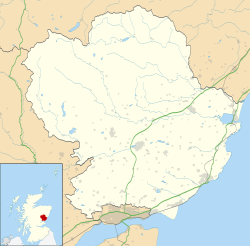| Newtyle | |
|---|---|
 Looking south towards the Sidlaw Hills. Left to right: Kinpurnie, Hatton, and Newtyle Hills. | |
Location within Angus | |
| Population | 680 (2020) [1] |
| OS grid reference | NO297413 |
| Council area | |
| Lieutenancy area | |
| Country | Scotland |
| Sovereign state | United Kingdom |
| Post town | Blairgowrie |
| Postcode district | PH12 |
| Dialling code | 01828 |
| Police | Scotland |
| Fire | Scottish |
| Ambulance | Scottish |
| UK Parliament | |
| Scottish Parliament | |
Newtyle is a village in the west of Angus, Scotland. It lies eleven miles (eighteen kilometres) north of Dundee in the southwest of Strathmore, between Hatton Hill and Newtyle (Heather Hill) in the Sidlaws. The village sits on gently sloping ground with a northwest aspect. The main communication link is the B954 road. The population was about 800 as of 2004 [update] . [2]
